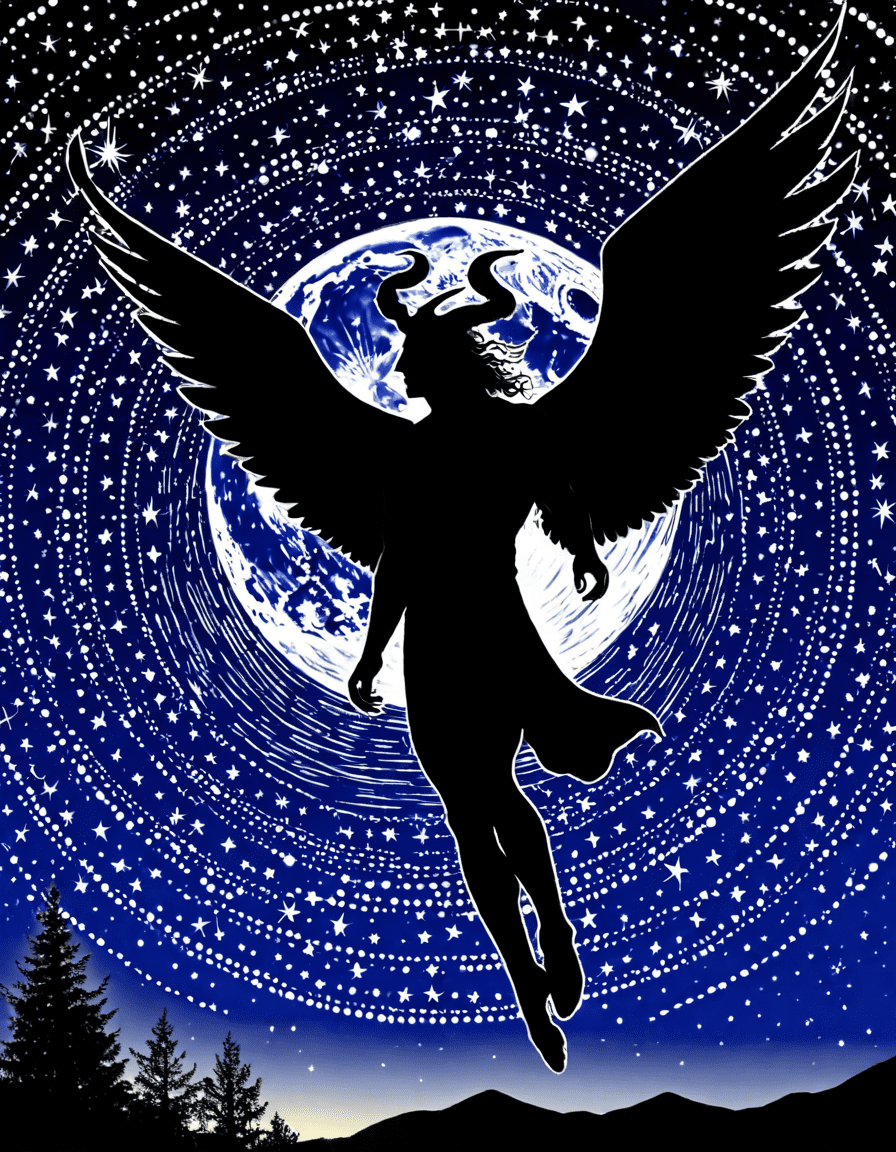The legend of the incubus has intrigued generations, weaving tales of nighttime terror and seduction. Rooted in cultures across the globe, the incubus represents more than just a myth. It reflects our deepest fears and curiosities about the nature of dreams and desires. But what’s the story behind this demon of the night? Let’s dive into the enchanting world of the incubus and explore its captivating legacy in film and folklore!

The Allure of the Incubus: Exploring the Legend of Dream Intruders
The incubus, often depicted as a handsome, dark figure, invades the dreams of unsuspecting victims, leaving them terrified yet strangely enchanted. This concept of dream intruders has evolved, influencing everything from medieval folklore to modern-day cinema. Movies like “Sinister” illustrate this fear beautifully, taking us through the nightmares of characters haunted by unseen presences. The incubus must keep its myth alive, highlighting themes of seduction, power, and the vulnerability of our subconscious.
Historically, the incubus served as an explanation for sleep paralysis and nocturnal panic. Imagine waking up in the middle of the night unable to move, as if a weight is pressing down on your chest. Creepy, right? This phenomenon often leads to tales of shadowy figures lurking nearby, preying on their victims. Whether it’s a shared cultural experience or something rooted in collective anxiety, the incubus remains forever entangled in our understanding of sleep and fear.
It’s fascinating how this legend blends traditional narratives with contemporary interpretations. For instance, the portrayal of the incubus has shifted from ancient folklore to cinematic interpretations that echo modern anxieties. Films and series dive deep into these themes, reminding us that while our fears may evolve, the essence of the incubus remains intact, lurking in the shadows of our minds.

Top 5 Distinct Characteristics of an Incubus and Its Counterpart, the Succubus
1. Nighttime Intrusiveness
The incubus embodies a fear that resonates with many, making nighttime a vulnerable playground for its haunting antics. You might recall how “Sinister” uses dreams to magnify its horror, keeping viewers on the edge of their seats. This nocturnal visitor feeds off nightmares, blending personal fears into its terrifying tableau.
2. Sexual Seduction
Unlike its counterpart, the succubus, the incubus typically targets male victims. Imagine being seduced in your dreams and waking up feeling drained. Historical figures such as Paracelsus hinted at the incubus’s capacity to sap a man’s very essence through these dream encounters. It’s this tension between desire and fear that opens discussion on sexuality and power dynamics, especially in the context of horror films.
3. Physical Manifestation
Traditionally, the incubus takes on an alluring yet terrifying appearance, with features that symbolize both dread and seduction. In films like “The Nightmare” (2015), these characteristics create a palpable tension, causing viewers to feel both attracted to and repulsed by the figure on-screen. On the other hand, the succubus often embodies a gentler allure, effectively showcasing a duality that invites analysis of both entities.
4. Cultural Variations and Symbolism
Not all cultures view the incubus as purely malevolent. Take the Slavic “Mora,” for example, seen as a guiding spirit leading souls to rest. This demonstrates how cultural narratives influence interpretations of both fear and protection. Could it be that the incubus acts as a reflection of cultural anxieties, especially when it comes to sexuality?
5. Psychological Interpretations
Modern psychology frequently views incubus experiences as manifestations of sleep paralysis or anxiety, echoing fears and desires lurking beneath the surface. Dr. Stanley Krippner’s work emphasizes how these experiences are rooted in repressed feelings, suggesting that the incubus serves as a metaphor for vulnerabilities we face in waking life. This intersection of folklore and psychology reveals deeper layers of the incubus legend.
The Evolution of the Succubus and Meru: A Closer Examination
As narratives surrounding the incubus and succubus have evolved, so too has the character of Meru in “Meru the Succubus.” This rendition takes a bold step towards portraying female empowerment, flipping the script on traditional succubus motifs. Here, Meru stands for agency, something particularly refreshing in today’s socio-cultural climate.
Meru reclaims her narrative, transforming from a mere symbol of temptation into a fully realized character with depth and agency. Instead of playing under a male lens, she challenges patriarchal perceptions and showcases a modern interpretation of sexuality.
The presence of these dream intruders in series like “Buffy the Vampire Slayer” further reflects their evolution. Vampires, incubi, and succubi all manifest as nuanced characters, highlighting complexities in relationships that share common themes of desire and fear.
The Incubus in Contemporary Culture: A Modern Renaissance
The incubus continues to capture the attention of filmmakers and writers today. From novels to blockbuster films, its story finds fresh interpretations, showcasing an intriguing resurgence of interest in ancient folklore. Directors like Guillermo del Toro breathe new life into these tales, infusing narratives with rich thematic layers that speak to overarching fears and desires within contemporary life.
This modern reign of the incubus is hardly just for nostalgia. As societal norms shift, the incubus embodies timeless fears about intimacy, control, and the complexities of human relationships. Each storytelling iteration reveals how we unravel layers of our collective psyche, using this ancient figure to explore the dark corners of our consciousness.
An incubus is more than just a dream intruder; it serves as a canvas for exploring deep-rooted concerns about desire, power, and fear that resonate across cultures and eras. Embracing its complex narratives enriches our engagement with both cinema and our understanding of ourselves. As we continue to confront the shadows lurking in our dreams, the incubus will always offer a haunting reflection of the human experience!
In wrapping up, the stories we tell today—the chilling tales of incubi, the fierce and empowering Meru, and the haunting presence of these figures—remain vital to grasping the shared fabric of our fears and desires. So, the next time you find yourself peeking into the dark corners of your dreams, remember: the incubus isn’t just a figment of folk tales; it’s a vivid representation of enduring human struggles.
Incubus: The Fascinating Legend of Dream Intruders
Disturbing Dreams and Their Origins
The incubus has long fascinated cultures around the globe—think of it as a nocturnal visitor with a notorious reputation for creeping into dreams. This malevolent entity is often depicted as a demon that targets women, leading to restless nights and some chilling experiences. Interestingly, people in ancient times usually explained sleep paralysis or nighttime anxieties as encounters with an incubus. Imagine waking up, unable to move, and feeling a dreadful weight on your chest. Sounds like something straight out of a horror flick, right? It almost echoes the struggles of some characters in shows like House Of Dragon, where power and fear intertwine in a dreamlike saga.
The Cultural Footprint of Incubi
What’s particularly intriguing is how the incubus myth pops up in various cultures, whether in medieval folklore or modern interpretations. For instance, in some ancient texts, the incubus is portrayed as a kind of romantic aggressor, seducing women while they sleep. This alluring but troubling figure has led to various artistic representations, from paintings to films akin to the Dolce Vita charm seen in classic cinema. Even in the realm of digital content, we find creators like Ms. Sethii exploring themes that share parallels with the incubus narrative, reflecting societal fears and desires.
From Folklore to Modern Pop Culture
With the incubus finding its way into the tapestry of modern storytelling, it’s no surprise that video games and films have capitalized on this legend. Characters like Lara Croft often face otherworldly challenges that mirror the creepy energy of the incubus mythos. It raises a fun question: how do folklore and gaming intertwine, bringing ancient terrors into our hyper-connected lives? Speaking of which, have you heard of Khan Baba? He’s been known to delve into these supernatural themes in his captivating narratives, creating a bridge between the past and present. As society continues to grapple with anxieties, the incubus remains a thrilling symbol of the fears that still haunt our dreams. Talk about a legacy that keeps on giving!
Whether you’re a fan of folklore or just enjoy a good ghost story, there’s something undeniably enticing about the incubus. From sleep paralysis to the representations in today’s media, this legend drifts through cultures like a whisper, echoing deeply in the collective consciousness. As you ponder your next movie choice or binge-watch trending shows, keep an eye out for how these dream intruders influence stories around us. After all, every good story needs a hint of mystery and a sprinkle of the supernatural—who can resist that?





